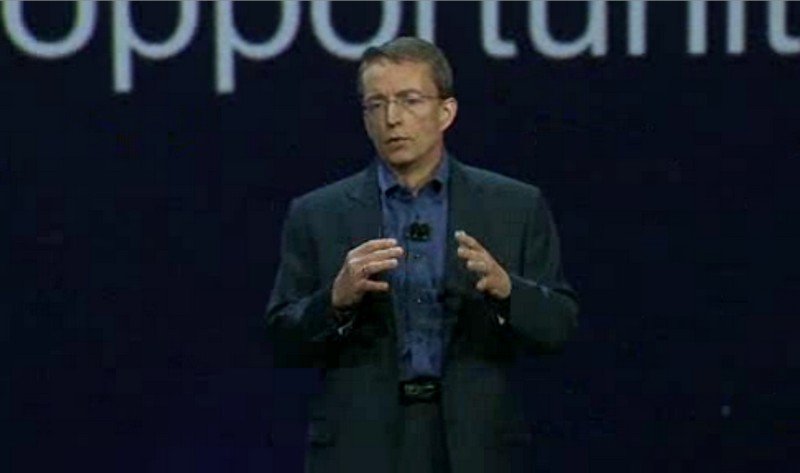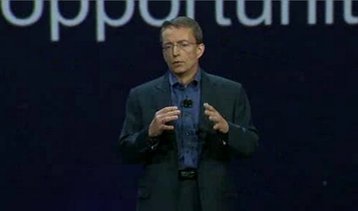The word ‘virtualization’ is sinking into the history of our industry, along with ‘microcomputer’ and ‘multicore.’ It implies a kind of conversion from the physical to the virtual realm that may no longer be necessary. What we had been calling ‘virtual infrastructure’ is today becoming ‘infrastructure.’
In an effort to cement its position in this new realm while, at the same time, defending it from a new and unpredicted onslaught, VMware on Monday unveiled an updated strategy at its annual VMworld conference in San Francisco. That strategy includes an operating system-like initiative with OEM partners including Dell and Fujitsu that will result, amid the chorus of “software-defined” resources, in VMware co-branded hardware.
It’s a product category VMware will try to call ‘hyper-converged infrastructure,’ the convergence here being the co-branding.
A virtual appliance for VMware’s partners
Vmware’s CEO Pat Gelsinger said: “with all components now available in the software-defined datacenter (SDDC), and the powerful common building block of the x86 servers, we can deliver a dramatically simpler, hyper-converged infrastructure solution.”
By ‘simpler,’ Gelsinger referred to a kind of automated deployment scheme with which co-branded hardware such as Dell’s is pre-configured to deploy VMware with about 15 minutes’ setup time.
VMware is calling this scheme EVO (said like a word, not as letters). Gelsinger went on to describe it as a “family of products that’s a simple, integrated solution that is the fastest way to deploy an SDDC. EVO is essentially the SDDC packaged with hardware, into a simple, easy-to-use solution.”
“Family” may be how VMware prefers to refer to EVO-branded products, but in the open market, they’ll be competitive against one another, and not like siblings. Each server that qualifies for EVO branding must meet minimum hardware requirements, although VMware was very careful to point out that these requirements did not constitute a reference architecture — meaning, it isn’t publishing a single parts list for its partners for their benefit only.
Partners will be permitted to exceed these specifications as they see fit.
In a VMware blog post Monday morning, CTO Chris Wolf (a former Gartner analyst) explained, “VMware will not sell EVO-based hardware solutions. We simply provide the software and specifications to our hardware partners, who will ship and support the EVO solutions. Our EVO solutions leverage vSphere as well as vSAN and local-attached storage.”
The EVO:RAIL brand will refer to mid-range enterprise servers pre-configured for VMware SDDC. At a minimum, these servers will contain two six-core Intel Xeon E5-2620 v2 processors, which Intel launched about this time last year. They’re clocked at 2.1 GHz standard frequency, with turbo at 2.6 GHz. They each have 15 MB of L2/L3 “smart cache” memory, and QuickPath Interconnect transfer speeds of 7.2 GT/s. It’s an affordable midrange processor with mediocre benchmark scores, and it’s glaringly obvious that it’s on the last stages of its product lifecycle.
Dell’s own announcement of its VMware EVO partnership stopped short of formally unveiling an actual server — an indication that Dell’s first entry may exceed the specs in ways we’re not familiar with yet.
EVO:RAIL co-branded systems will be pre-equipped with ESX hypervisor and vSphere management tools, vCenter Server orchestration system, and VMware Virtual SAN. It also contains tools that serve as an on-ramp to the hybrid cloud service that VMware recently rebranded as vCloud Air.
The self-deploying data center
Down the road a ways in VMware’s timeline is EVO:RACK, whose technology preview was released to VMworld attendees Monday. Whereas VMware is positioning EVO:RAIL configurations as best suited for specific functions, such as hosting a SaaS application or a VDI infrastructure on-premise, EVO:RACK is intended to enable rack-level scaling by means of virtual abstraction. Specifications have not yet been released for EVO:RACK, though VMware officials did say Monday its intention is to be compatible with the VCE Vblock systems VMware already produces in collaboration with parent EMC and with Cisco, as well as with the Open Compute Project specification — the “open letter” that Facebook presented to all server manufacturers, describing the parts it would buy to populate its growing cloud.
“Another component of our strategy here is making these technologies broadly available to the industry,” Gelsinger said. “We expect that EVO:RACK will be available on OCP-compliant hardware, and we’re making code contributions of the low-level management technology, to make it broadly available to the industry through OCP as open source contributions as well.” He added EVO:RACK aims to enable a fully-scaled out cloud datacenter in two hours or less.
But it’s not an open source specification — not really. Unlike OpenStack, whose specifications are free for vendors to adopt, EVO is being presented exclusively to VMware partners. While the open source contributions VMware makes to OCP may enable contributors to write management software that runs on EVO:RAIL and EVO:RACK systems, EVO is designed to give Dell, Fujitsu, and the others a leg up on emerging SDDC competition from HP, Oracle, and maybe somebody named Lenovo.
No specific vendors have jumped on the EVO:RACK side of the bandwagon just yet, although San Jose-based Supermicro, China’s Inspur, Japan’s Net One Systems, and VMware parent company EMC are also listed as EVO hardware partners. (Some say EMC missed its opportunity to dive into the x86 server field when IBM sold its x86 business to Lenovo.)
“Why do we do infrastructure?” asked VMware’s Gelsinger at one point. Perhaps wishing later he’d chosen his phraseology less ambiguously, he went on, “Infrastructure is not an end unto itself; it’s an end to applications. It’s all about running apps. And today, we have this changing app landscape that says, ‘Some believe that I need a new silo of infrastructure to run third-generation apps.’
“A new silo of infrastructure? No!” he literally squealed, echoing through Moscone Center in a way Steve Jobs’ voice never did. “That’s the problem that virtualization is out to solve in the first place! No hardware silos! So today we’re going to disprove that myth as well, and we’re going to offer more choice.”
While VMware announced additional support for OpenStack-based orchestration configurations as an alternative to vSphere, EVO co-branded systems will be, in the company’s words, “100% powered by VMware software.”


